One Woman's Reminiscences of Wartime As a Child
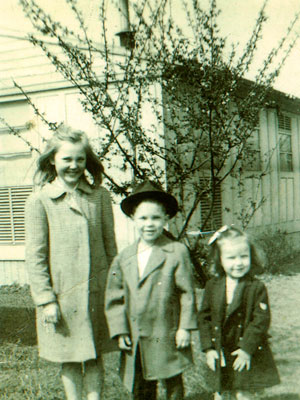 Judie Wood (right) stands next to a Parkside Homes defense project house with two children who shared a house with her during World War II. Romona stands to the left while Merlyn wears a fedora hat and "man of the house" clothing. Judie's mother and Romona and Merlyn's mother shared the house and both worked at the sprawling OSC shipyards. (Image courtesy Judie Silcox)
Judie Wood (right) stands next to a Parkside Homes defense project house with two children who shared a house with her during World War II. Romona stands to the left while Merlyn wears a fedora hat and "man of the house" clothing. Judie's mother and Romona and Merlyn's mother shared the house and both worked at the sprawling OSC shipyards. (Image courtesy Judie Silcox) While vicious battles raged around the world and the home front economy and society retooled to support the war effort, children had a unique vantage point to the historical changes. Many saw the war through a lens of war services such as
defense housing and
child care. They saw their mothers leave traditional roles in the house to work in shipyards and factories while their fathers fought overseas. If these children didn't have a keen understanding of events, they did sense the profound and historic nature of the times, which cemented their memories decades later.
Judie Silcox's Reminiscences
Judie Silcox still had strong memories in 2015 of her life as a young child in Portland during and after World War II. She was born Judith Andrea Wood on Feb. 1, 1942. Her father served in the army until his death in April 1945. Her mother, Lucille E. Fink Wood, worked as a welder at the Oregon Shipbuilding Corporation (OSC) shipyards. The facility was one of three in the area built by industrialist Henry J. Kaiser to supply ships for the war effort.
Judie and her mother shared defense housing at Parkside Homes with another woman, who also worked at the shipyards, and her daughter and son. Parkside Homes, near Pier Park in north Portland, was one of many housing projects built by the the newly-created Housing Authority of Portland in response to the flood of war industry workers moving to Portland. Judie lived there until late 1946 when her mother remarried.
The new family then moved to St. Johns Woods, a 967-unit Housing Authority of Portland project located in north Portland. According to former resident Jim Cole, this large development consisted of small single homes built in clusters of four or six units. The walls were thin and the insulation was poor, making for cold winters.
Footnote
1 Judie's stepfather adopted her in 1947 and she became Judith A. Smith. The family lived at St. Johns Woods until the early 1950s.
In Her Own Words

Judie's reminiscences are presented below in her own words with minor edits. She focuses on key aspects of her life during that period: the Kaiser OSC child care center, her mother's role as a welder, and life in the defense housing projects. The text is illustrated with images she submitted to the Oregon State Archives with her memories as well as additional images.
Child Care Center Memories
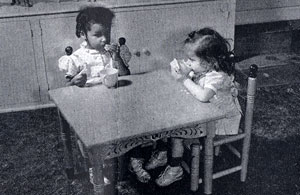 Girls at a child-size table at a Kaiser child care center. (Image source:
Footnote
2)
Girls at a child-size table at a Kaiser child care center. (Image source:
Footnote
2)
Judie's Memories
1) The wading pool (although, in my mind it was a swimming pool like rich people enjoyed) and the time we all ran around the pool in only our underwear and teachers sprayed us with hoses.
2) My third birthday party celebration—Each child’s birthday was celebrated. I seem to remember sitting in the center of a table that was in front of the room. For some reason, I remembered the table on a low-rise dais, but I think this is a distorted memory. Probably, just felt elevated at that moment.
3) Art easels, books, books, and more books, and those wonderful, caring teachers.
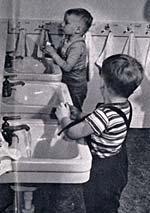 Child-size sinks and toilets helped children learn to take care of themselves. (Image source:
Footnote
2)
Child-size sinks and toilets helped children learn to take care of themselves. (Image source:
Footnote
2)
4) Those very special small toilets. [Later, when I went to kindergarten at Sitton, there were large toilets with overhead flush systems which scared me to death.] During my Kindergarten year, the Shipyard child care center was converted it to a public school which I was able to attend for the first through third grade. I do believe the return to small toilets was my favorite memory of the return my school.
Kaiser OSC Child Care Center
I vividly remember my first day at the Kaiser OSC child care center. I was not a happy camper. Placed in the infirmary—a large white room with nurses in white—I then had to suffer the indignity of being placed in a white crib! At home, my mother and I shared a bed so I thought the crib was an insult—a crib was for babies. And that first day included shots—I particularly remember my small pox vaccine—so I let my mother know in no uncertain terms that I did not want to return—and probably let the nurses know too. I remember my mother explaining that the crib situation was only for a few days and then I was going to get to go school with lots of children. Apparently, I accepted this condition and have nothing but fond memories of the center after being “sprung” from the captivity of the infirmary. Years later I asked my mother how old I was when I started the child care center, and she said “22 months”…so you see, the child care center was a very impressive place!
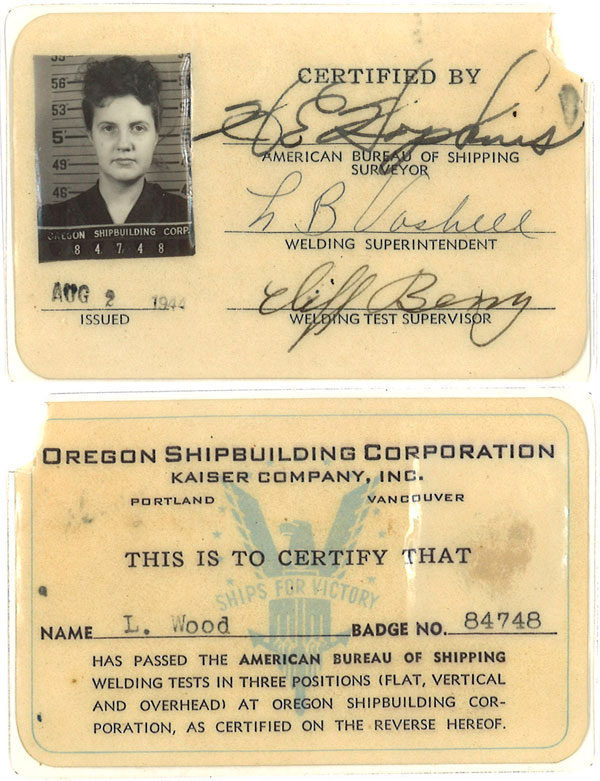 Welding certificate card for Judie's mother, Lucy Wood. (Image courtesy Judie Silcox)
Enlarge image
Welding certificate card for Judie's mother, Lucy Wood. (Image courtesy Judie Silcox)
Enlarge image I think I realized even as a small child how lucky I was to be in a place that felt so safe and secure—and so very much fun. As an adult I know how important this early intervention in my development was and how it contributed to my attitude towards education and my sense of independence. The only negative that I take with me is that I still can taste cod liver oil when I slice an orange—the cod liver oil served with orange juice was a daily routine in the center, which my mother continued for years!
My Mother the Welder
Mom and her friends seemed to have a lot of fun as well as work hard at the OSC shipyards. I remember her leather overalls and the pungent odor. They may have been my grandfather’s as he owned a small bronze factory. One time Mom came home laughing because she no longer had eyelashes and eyebrows—there was a flash fire under her hood. She probably had a couple of beers on the way home to take care of any pain. I know she was always proud of the work she did—but was also happy to stay home after the war ended.
Defense Worker Housing
My father was in the army in Europe so my mother and I shared a defense house (more like a cabin) with another woman and her two children, Romona and Merlyn. Merlyn was a year and half older than me and my very best friend as well as partner in mischievous activities. Merlyn attended the Kaiser OSC child care center too, but I think Romona was in school—she may have attended an after school program.
Our two bedroom, living room, eating space and kitchen was quite small but adequate.
Both our mothers worked at the OSC shipyards and I believe the defense housing project was called Parkside. My father had a silver “dog tag” made for me so I know our address was 8509 N. Commando [
See Google Map detail]. Our two bedroom, living room, eating space and kitchen was quite small but adequate. My mother loved the woodstove in the kitchen—she said it cooked better than an electric stove. I loved the wood (coal?) shed outside in our front yard. I would play by the hour on its roof and thought of it as my castle.
A chore we children shared was to draw the black curtains to meet the blackout requirements since we were so near the shipyards. Somehow it just made us cozier rather than fearful, although we children were always aware of the war and the sacrifices being made by others. We were probably reminded most often of these sacrifices when we “begged” for more things—as children always do!
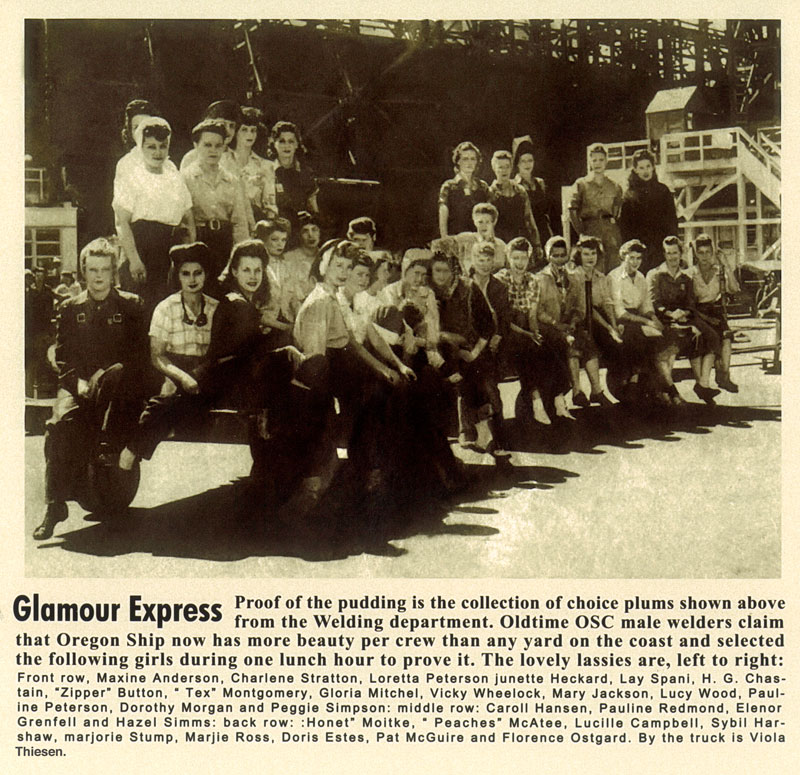 Judie's mother, Lucy Wood, is shown in this newspaper photo of the "choice plums" in the Welding Department at the Oregon Shipyards. (The Oregonian newspaper clipping courtesy Judie Silcox)
Enlarge image
Judie's mother, Lucy Wood, is shown in this newspaper photo of the "choice plums" in the Welding Department at the Oregon Shipyards. (The Oregonian newspaper clipping courtesy Judie Silcox)
Enlarge image
Our house was located on a short street and I remember there was a manned military guard station nearby. One time Merlyn and I found a dime and “post haste” asked the guard to call us a taxi to take us to St. Johns so that we could buy an ice cream cone. The guard called our mothers instead. Merlyn and I had many good plans foiled by caring neighbors and guardsmen! But we always tried to be helpful. One time we ran out of gas, but while our mothers left to get some, Merlyn and I “fixed the car.” When they returned with gas we proudly proclaimed we fixed it by putting “sugar” [nearby sandy dirt] in the gas tank. I am not sure how our mothers managed to get the tank fixed during war time, but Merlyn and I were definitely “underappreciated” for our effort.
Uncle Mac, a neighbor who worked the night shift at the shipyards worked in his
victory garden by day and it was his generosity that left me with a lifelong love for those tiny cucumbers. Other neighbors shared shoe
rations with us because as children our feet grew so fast. These were just some signs of neighbor’s generosity.
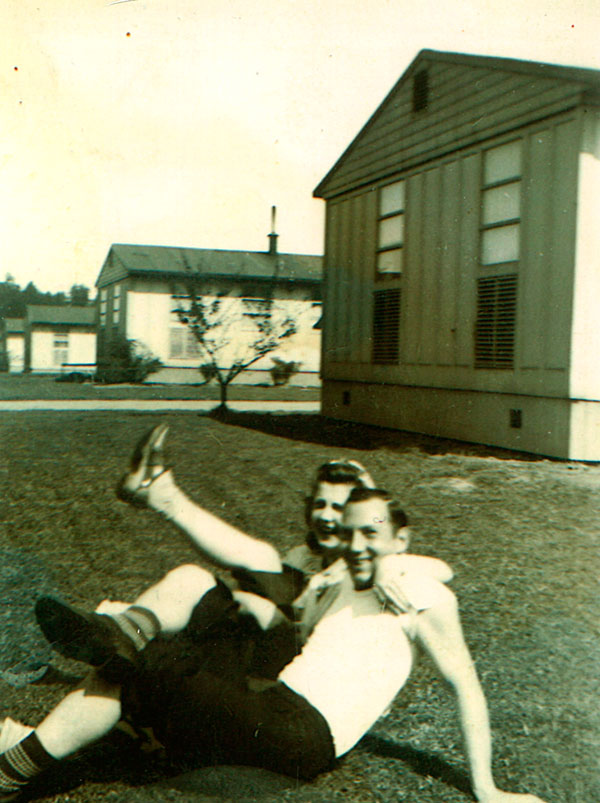 “Mom and soon to be Daddy—taken at Parkside Defense Housing—Glad the War is over!" (Image courtesy Judie Silcox)
Enlarge image
“Mom and soon to be Daddy—taken at Parkside Defense Housing—Glad the War is over!" (Image courtesy Judie Silcox)
Enlarge image The war barely ended when an oil tank (or more than one) near the shipyards exploded. Merlyn’s mother grabbed me under one arm and Merlyn under the other and headed for the car. We were all frightened that we were being bombed when cooler heads prevailed and my mom realized it was probably not a bomb—and we had nowhere to go anyway!
Another post war memory sticks in my mind. Soon after the war, my mother managed to buy me a new blue Schwinn tricycle and it was delivered in a huge wooden crate. The entire neighborhood uncrated it in our front yard. Uncle Mac took some of the wood to make pedal adjustors—it was so exciting for everyone, because no one had been able to get new toys made from metal during the war and this was a symbol that the war and all its sacrifices was starting to be behind us.
During the Vanport flood, my father was deputized and he brought home several people who slept on our living room floor and couch. Our neighbors also took in many victims of the flood.
My father died during the war and my mother remarried a WW II veteran when I was almost 6 and we went to live in St. Johns Wood. We lived there until 1950-51.